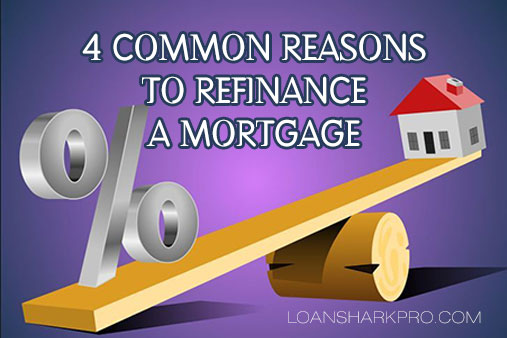
Refinancing a mortgage is essentially paying off your existing mortgage and taking out a new one at a lower interest rate, typically decreasing the amount of your payments. You may also opt for a shorter-term mortgage, which may offer somewhat higher payments.
Homeowners choose to refinance a mortgage for a wide variety of reasons. Some of the most common ones are to:
- Obtain a lower interest rate. Obtaining a lower mortgage interest rate can lower your monthly payment and is the most common reason homeowners refinance. Building equity faster is also a popular reason because owning a home can be one of the safest and most profitable investments you can make.
When you refinance to lower your interest rate, you can significantly reduce your monthly mortgage payment, so long as you don’t increase your mortgage principal amount (as in a cash-out refinance). It’s important, however, to evaluate how long you plan to remain in your home. If you plan to stay in your home for several years, evaluate whether the cost savings resulting from a lower interest rate outweigh your refinancing fees. If you plan to sell your home in the near future, refinancing may not be your best option. - Build equity faster. You may want to build equity in your home more quickly than when you first obtained your mortgage. In this case, ask your loan officer about a mortgage with a shorter term.
For example, if you have a 30-year mortgage, you may want to refinance to a 10-, 15- or 20-year mortgage and build equity faster. This approach typically makes sense for homeowners who can afford an increase in their monthly mortgage payment. Each month, a certain part of the monthly payment goes toward the interest expense on the loan; the remainder is applied to the principal (some is also usually apportioned to escrow and taxes).Generally, the shorter a loan term, the higher the payment, but a greater percentage of that monthly payment is applied to the principal. Change loan type! You may have selected an adjustable-rate mortgage (ARM) when mortgage interest rates were higher than rates today. To ensure you had the lowest monthly mortgage payment possible, you probably found the ARM most attractive because it had a lower interest rate than a fixed-rate loan in the early years. When interest rates drop, however, refinancing to a fixed-rate loan can guarantee a lower rate for the life of the loan-as opposed to the interest rate on an ARM, which can adjust yearly or even twice a year, depending on the type of ARM you select.Some financial institutions may offer ARMs with a “conversion period,” which allows you to convert from an ARM to a fixed-rate mortgage, without refinancing.
- Take advantage of an improved credit rating. Today, there are many ways for borrowers with impaired credit to get a mortgage. Typically, they may have to take out a mortgage with a higher interest rate than borrowers with a better credit history. But over time, these homeowners can improve their credit rating and choose to refinance to obtain a loan with different terms and a lower interest rate.
Refinancing may save you a significant amount each month, if you are now in a high interest rate loan that was the only type of loan offered to you because of your past credit. - Draw on equity already built in the home. If you’re looking to tap into the equity you’ve built in your home, ask about a cash-out refinance. With this option, you receive cash at closing. Homeowners generally choose this type of refinancing to pay for their children’s education, home improvements, debt consolidation or other needs. A lender will typically require a homeowner to have at least 5% equity accumulated in the property for this type of refinancing. Equity is the difference between what the property is worth and the amount still owed on the mortgage.
For example, if the house is valued at $100,000 and the mortgage balance is $90,000, the equity is $10,000 (10% of house value). If you are considering a cash-out refinance for the added flexibility it may provide in helping you manage your expenses, first consider whether you will be getting your debt under control or increasing it.
Refinancing Mortgage to Save Money
Your goal is to save money by lowering your payments? Take the costs of getting the loan and divide that by the monthly payment savings. This will tell you how many months it will take you to break even on the costs and start saving money over the long term. you should refinance, if you plan on staying in the home past this future date. When the cost break-even point is under 36 months, you should do the refinance. Consider it carefully, if it takes 36-60 months. Longer than 60 months? It probably is not wise to refinance at this time. Be sure the rate is dropping enough to recover the costs as if the refinance was a 30-year loan, if your goal is to refinance to a shorter term loan (i.e. go from a 30-year to a 15-year) and pay off your house faster. If it doesn’t, you should just start pre-paying principle on your current loan at the 15-year payment amount instead of refinancing and paying costs.
An experienced loan officer will do these calculations for you so you can understand them to see if you are truly saving money.
Refinancing Mortgage to Get Cash
The most common refinance is to get cash to consolidate bills. Consumers do this to lower their total payments, take advantage of lower rates on home loans as opposed to higher rates on credit cards or auto loans, possible tax benefits, pay off everything including the house faster and many other personal reasons. You can get cash for any purpose you want, including home improvement, cars, boats or RV purchases, investments, family needs such as college tuition and anything else for which cash is needed. For years, the common 30-year fixed first mortgage has allowed you to borrow up to 80% of the appraised value for the refinance loan amount, pay off your existing mortgages and costs and keep the cash difference. Now there are loan programs that go to 90% of the appraisal at slightly higher rates and even 100% of the appraisal at even higher rates. If you are looking to get a lot of cash and are considering the 90% or 100% program, be sure to compare the payments against the extra cash.
You may find the 80% of the appraisal loan amount is a better value for what you want and still leaves you spare equity if needed at a later time.
When should I refinance a mortgage?
A good rule of thumb is, if the cost break-even point is 3 years or less, you should refinance. If it takes 3-5 years to recoup the costs, weigh your decision carefully. Longer than 5 years it is probably not advisable to refinance. To find your break-even point take the cost of getting your mortgage refinanced and divide that by the monthly payment savings. This will tell you how many months it will take you to break even on the costs and start saving money over the long term. You should also refinance, if you plan on staying in the home past this future date.
Timing the interest rate market is difficult. There is a common misconception that you need to save 2%, but this applied when consumers owed $30,000 to $40,000 on their homes. At the average home in the $150,000 range today, even a 1% savings may be worthwhile. If you are consolidating bills or paying off a second mortgage, the mortgage interest rate could even rise and save you money. Look at the entire picture of your finances as they are now and look at all the refinance options. It could be worth your time to talk with an experienced loan officer. Then choose what puts you in the best financial position.
Many homeowners consider refinancing when interest rates suddenly fall or there’s a change in financial circumstances. But even though a large decline in rates or an opportunity to pay off debts might make refinancing seem like an easy decision, you shouldn’t consider any single variable on its own. Think about how long you plan to stay in your home, how you plan to use your equity and how a refinance will support your overall financial goals.
There are some situations in which a refinancing decision should invariably be made:
- If you are able to negotiate a no-cost mortgage (you pay no points or closing costs) and if the new mortgage rate is lower than your existing rate, then refinancing your loan would certainly be of financial benefit to you.
- If the remaining mortgage balance, including points and closing costs, can be refinanced at a reduced monthly payment and still be paid off within your existing mortgage payment term, then refinancing would be highly advisable.
- If you need extra cash for a home equity or auto loan and the mortgage rate is lower than alternative loan rates, then refinancing is probably the best choice.
- Lastly, you can generally count on it being time to refinance when your new mortgage rate is at least one to two points lower than your existing rate and you plan to stay in your home for at least three to five years.




